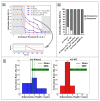Cellular Mechanosensitivity: Validation of an Adaptable 3D-Printed Device for Microindentation
- PMID: 35957122
- PMCID: PMC9370482
- DOI: 10.3390/nano12152691
Cellular Mechanosensitivity: Validation of an Adaptable 3D-Printed Device for Microindentation
Abstract
Mechanotransduction refers to the cellular ability to sense mechanical stimuli from the surrounding environment and convert them into biochemical signals that regulate cellular physiology and homeostasis. Mechanosensitive ion channels (MSCs), especially ones of Piezo family (Piezo1 and Piezo2), play a crucial role in mechanotransduction. These transmembrane proteins directly react to mechanical cues by triggering the onset of an ionic current. The relevance of this mechanism in driving physiology and pathology is emerging, and there is a growing need for the identification of an affordable and reliable assay to measure it. Setting up a mechanosensitivity assay requires exerting a mechanical stimulus on single cells while observing the downstream effects of channels opening. We propose an open-hardware approach to stimulate single adherent cells through controlled microindentation, using a 3D-printed actuation platform. We validated the device by measuring the mechanosensitivity of a neural mice cell line where the expression level and activity of Piezo1 were genetically and pharmacologically manipulated. Moreover, this extremely versatile device could be integrated with different read-out technologies, offering a new tool to improve the understanding of mechanotransduction in living cells.
Keywords: 3D printing; mechanobiology; mechanosensitivity; mechanotransduction; piezo1.
Conflict of interest statement
The authors declare no conflict of interest.
Figures






Similar articles
-
Synergy between Piezo1 and Piezo2 channels confers high-strain mechanosensitivity to articular cartilage.Proc Natl Acad Sci U S A. 2014 Nov 25;111(47):E5114-22. doi: 10.1073/pnas.1414298111. Epub 2014 Nov 10. Proc Natl Acad Sci U S A. 2014. PMID: 25385580 Free PMC article.
-
Piezo proteins: incidence and abundance in the enteric nervous system. Is there a link with mechanosensitivity?Cell Tissue Res. 2019 Mar;375(3):605-618. doi: 10.1007/s00441-018-2926-7. Epub 2018 Oct 15. Cell Tissue Res. 2019. PMID: 30324494
-
Roles of mechanosensitive channel Piezo1/2 proteins in skeleton and other tissues.Bone Res. 2021 Oct 20;9(1):44. doi: 10.1038/s41413-021-00168-8. Bone Res. 2021. PMID: 34667178 Free PMC article. Review.
-
A Plug-and-Latch Mechanism for Gating the Mechanosensitive Piezo Channel.Neuron. 2020 May 6;106(3):438-451.e6. doi: 10.1016/j.neuron.2020.02.010. Epub 2020 Mar 5. Neuron. 2020. PMID: 32142647
-
Mechanosensitive Piezo1 and Piezo2 ion channels in craniofacial development and dentistry: Recent advances and prospects.Front Physiol. 2022 Oct 21;13:1039714. doi: 10.3389/fphys.2022.1039714. eCollection 2022. Front Physiol. 2022. PMID: 36338498 Free PMC article. Review.
Cited by
-
Towards Polycaprolactone-Based Scaffolds for Alveolar Bone Tissue Engineering: A Biomimetic Approach in a 3D Printing Technique.Int J Mol Sci. 2023 Nov 10;24(22):16180. doi: 10.3390/ijms242216180. Int J Mol Sci. 2023. PMID: 38003368 Free PMC article. Review.
-
Biophysical assays to test cellular mechanosensing: moving towards high throughput.Biophys Rev. 2024 Dec 20;16(6):875-882. doi: 10.1007/s12551-024-01263-w. eCollection 2024 Dec. Biophys Rev. 2024. PMID: 39830126 Free PMC article. Review.
References
-
- Chen X., Wanggou S., Bodalia A., Zhu M., Dong W., Fan J.J., Yin W.C., Min H.K., Hu M., Draghici D., et al. A Feedforward Mechanism Mediated by Mechanosensitive Ion Channel PIEZO1 and Tissue Mechanics Promotes Glioma Aggression. Neuron. 2018;100:799–815.e7. doi: 10.1016/j.neuron.2018.09.046. - DOI - PubMed
-
- Ranade S.S., Qiu Z., Woo S.H., Hur S.S., Murthy S.E., Cahalan S.M., Xu J., Mathur J., Bandell M., Coste B., et al. Piezo1, a mechanically activated ion channel, is required for vascular development in mice. Proc. Natl. Acad. Sci. USA. 2014;111:10347–10352. doi: 10.1073/pnas.1409233111. - DOI - PMC - PubMed
-
- Alcaino C., Knutson K.R., Treichel A.J., Yildiz G., Strege P.R., Linden D.R., Li J.H., Leiter A.B., Szurszewski J.H., Farrugia G., et al. A population of gut epithelial enterochromaffin cells is mechanosensitive and requires Piezo2 to convert force into serotonin release. Proc. Natl. Acad. Sci. USA. 2018;115:E7632–E7641. doi: 10.1073/pnas.1804938115. - DOI - PMC - PubMed
LinkOut - more resources
Full Text Sources

